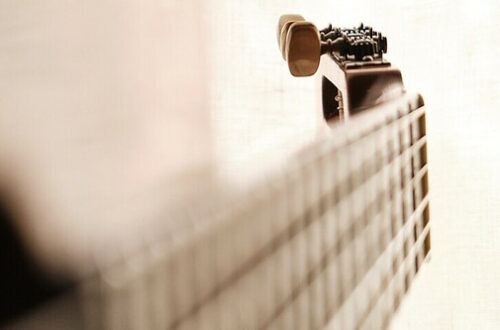
How To Choose Your First Acoustic Guitar
For acoustic guitar beginners, this moment marks the beginning of a profoundly personal musical journey. Selecting the best starter guitar is a right of passage—one filled with anticipation and excitement. But, as with any meaningful quest, it can also be laced with uncertainty. That’s why we’re here with an in-depth guitar-buying guide to smooth the path ahead.
Table of Contents
- Understanding the Different Types of Acoustic Guitars
- How To Choose Your First Acoustic Guitar
- What to Look for in Your First Acoustic Guitar
- Acoustic Guitar Sizes and What They Mean For Players
- Recommended Brands and Models for Beginners
- My Starter Guitars Within Your Budget
- Tips for Finding Value for Money
- Buying Your Guitar Online Stores vs Local Music Shops
- Essential Accessories for Your New Guitar
- Maintaining Your Acoustic Guitar for Longevity
- Conclusion
Understanding the Different Types of Acoustic Guitars
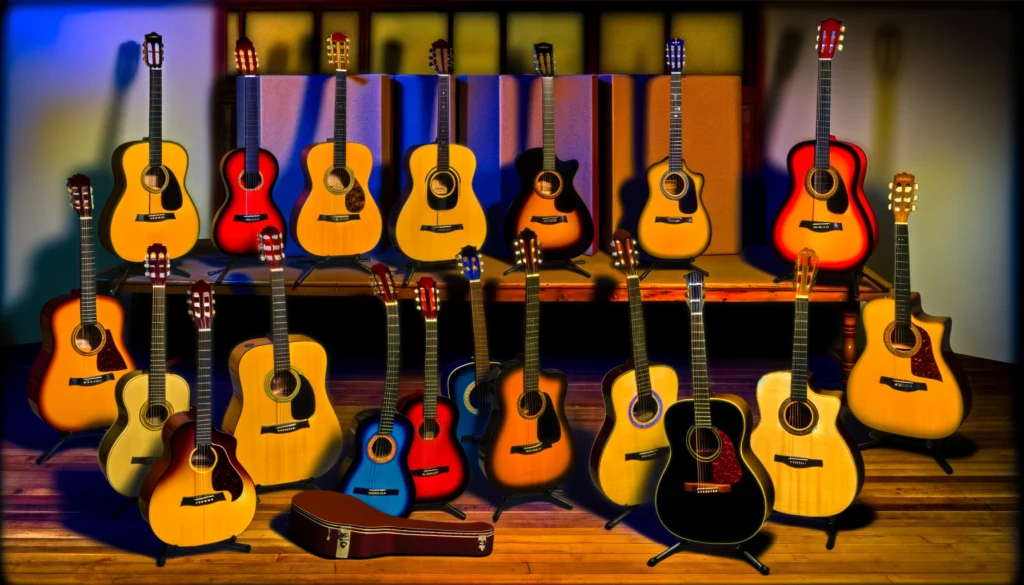
Stepping into the world of guitar-playing, we’re greeted with a spectrum of styles each resonating with its character. To the aspiring musician, discerning the right type of acoustic guitar is essential, not just for ergonomics and aesthetics, but for the tonal qualities that define one’s music.
Acoustic Guitar Styles
Start by asking yourself a simple question, what kind of music pulls at your heartstrings? Is it strumming chords to accompany your voice or picking intricate melodies?
For me, intricate melodies are my thing, but the music genre you love will greatly affect the kind of acoustic guitar that strikes a chord with you. If you’re not yet sure about the music style you want to explore, don’t fret—there’s always a guitar out there perfectly suited for you.
Below I have listed some of the guitar types you are likely to come across, along with a generalised list of genres for each guitar type…
- Dreadnought Musical Types: Folk, Country, Bluegrass, Rock
- Parlor Blues, Folk, Fingerstyle
- Jumbo Country, Bluegrass, Folk, Pop
- Classical (Nylon-string) Classical, Flamenco, Bossa Nova
- Auditorium/Grand Auditorium Fingerstyle, Folk, Light Rock
- Concert Fingerstyle, Jazz, Blues
- Travel/Mini Guitars Portable for various genres, often used for practice or travel.
How To Choose Your First Acoustic Guitar

By this point, you should have a good understanding of the various acoustic guitars and the music styles they’re best suited for. Next, I’m eager to dive into the unique sounds and effects each guitar can produce. However, there are more critical aspects to consider first when you’re about to buy your first ever guitar. So, let’s get into them.
Playability
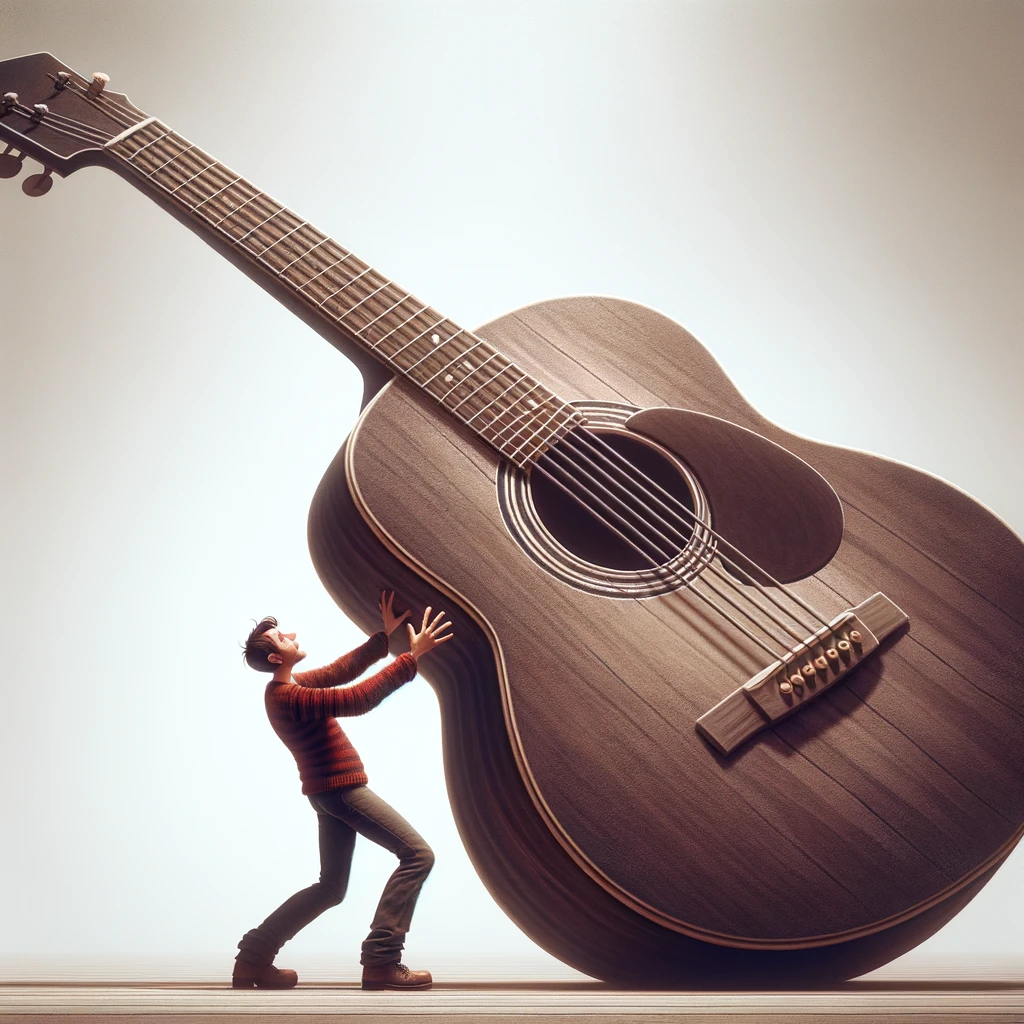
First and foremost, the importance of a guitar that fits seamlessly with your physique cannot be overstated. Learning the guitar is undoubtedly a challenge at the best of times, and the last thing you need is an instrument that adds unnecessary discomfort to the mix. The key player in this comfort equation? Guitar size.
The physical attributes of a guitar significantly impact its playability. Particularly for beginners, the breadth of the neck, the spacing of the strings, and the action—how high the strings are from the fretboard—can either act as facilitators or barriers to learning.
Hence, you’ll want to select a guitar that feels comfortable in your hands, easy on your fingertips, and doesn’t cause strain as you learn to form chords and navigate the fretboard.
- Neck Width: Thinner neck width can be more Ideal for players with smaller hands. Thicker neck widths may be better for people with larger hands.
- Wider String Spacing: Offers comfortable fingerpicking.
- Action Height: Low action reduces finger fatigue.
Beginner-Friendly Features
Certain features in guitars make the learning process a tad smoother. Built-in tuners simplify the tuning process. I bought a Tanglewood guitar last year with a built-in tuner and it’s a godsend.
Low action allows for easier chord pressing and reduces finger strain. These features are especially advantageous for those just starting their musical journey, as they help keep the focus on learning and enjoyment rather than wrestling with the instrument.
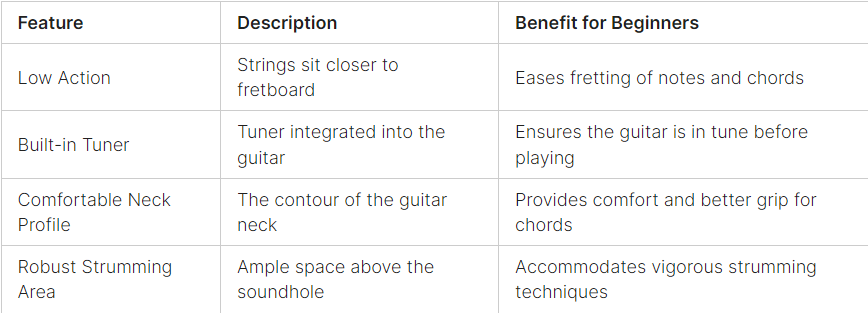
The quest to discover the ideal acoustic guitar as a beginner should prioritize your ease of learning and the sheer joy of making music. Look into the tactile world of guitars with these factors in mind, and you’ll find an instrument that not only sounds enchanting but also beckons you to play day after day.
Comparing Acoustic and Acoustic-Electric Models
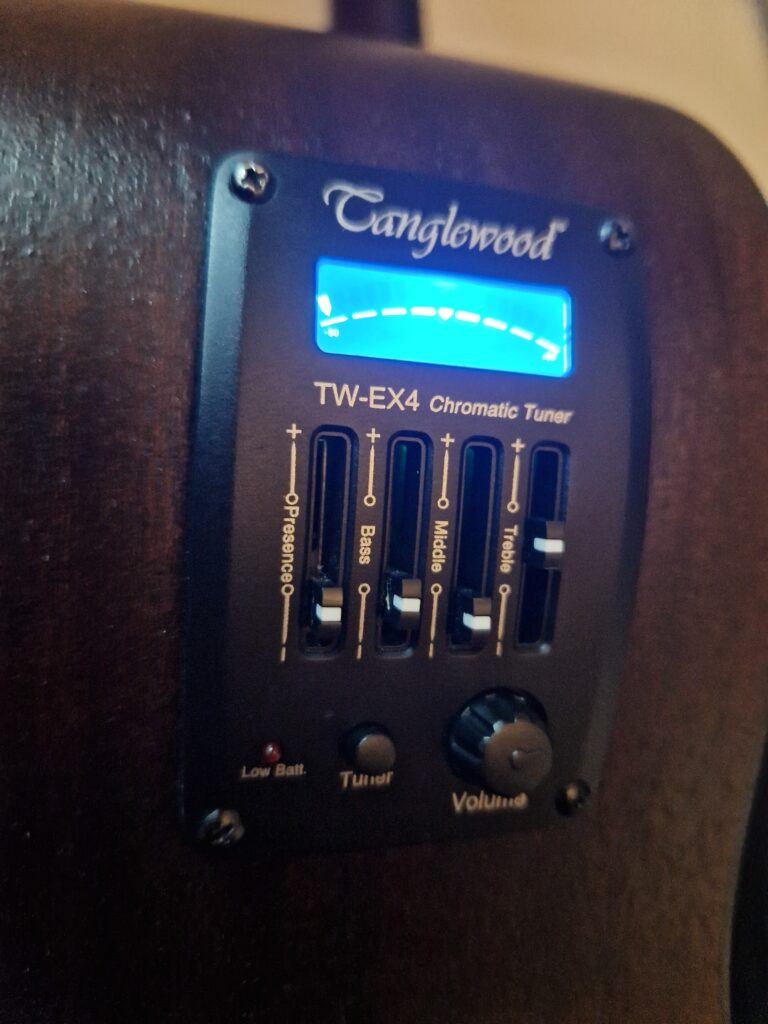
The modern musician’s landscape is dotted with scenarios that demand both unplugged authenticity and amplified presence.
These hybrids come equipped with built-in pickups and tuners, discretely tucked away, capturing the guitar’s natural resonance and translating it to amplifiable signals without diminishing its acoustic sound.

Whether your looking for the simplicity of a traditional acoustic guitar or the adaptability of an acoustic-electric, we as beginners have the privilege to choose a path that aligns with our musical aspirations.
Not to be overlooked, the materials that forge these instruments, be it spruce, mahogany, or rosewood, to name a few, significantly mould their tonal identity. The journey towards finding your acoustic guitar is one of exploration, and with each guitar’s material and style lies a step in discovering your unique sound.
What to Look for in Your First Acoustic Guitar
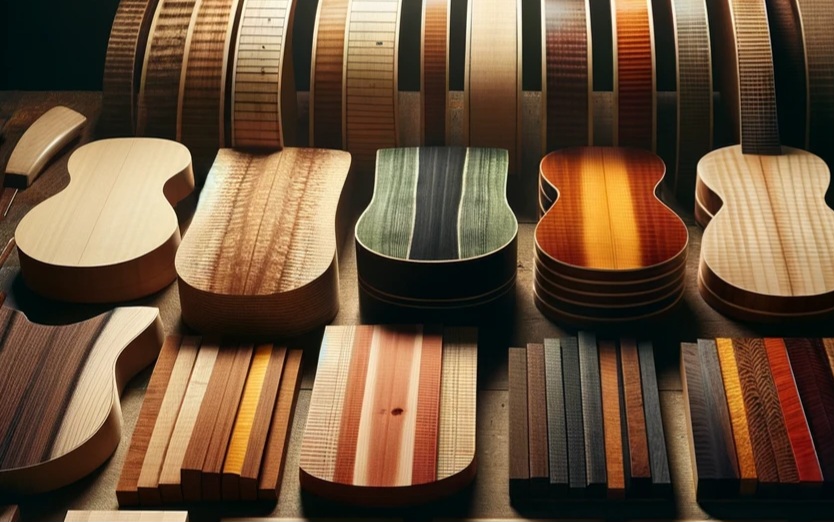
As we move into the world of music, it is best practice to understand guitar build quality and guitar materials. These are the cornerstones of an instrument’s ability to produce enchanting sounds and withstand the test of time.
Although I would not put guitar materials on the top of the list of importance when it comes to buying your first guitar, it is still worth noting the differences between a quality-made guitar and a lower-end production guitar.
Solid Tops

A beginner might wonder why a solid wood top is often recommended. The answer lies in the tonal richness and clarity it provides—characteristics that are integral to a fulfilling playing experience, particularly when compared to laminate options.
For many budget-friendly guitars, laminate tops are common. This isn’t necessarily a downside, especially for beginners. Honestly, the difference between solid and laminate tops might not be significant at your learning stage.
If you’re able and keen to get a guitar with a solid top, by all means, go for it. However, if you’re watching your budget, believe me, you can still produce wonderful music with a more affordable guitar. Having a solid top isn’t a must for quality sound; ultimately, it’s your playing skill that makes the biggest difference. Even with a less expensive instrument, skilled guitarists can bring out incredible sound.
Adjustable Truss Rod
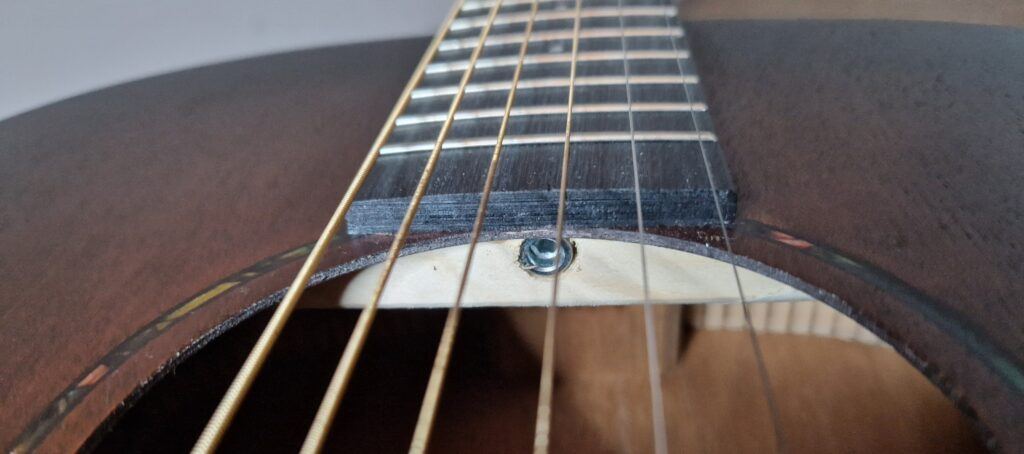

Let’s not forget the importance of functionality. We’re on the lookout for guitars that feature adjustable truss rods and consistent tuning machines. When it comes to guitars, particularly the more affordably priced ones, a significant compromise made to reduce costs can be the absence of truss rods.
Truss rods are crucial components within the guitar’s neck, designed to counteract the constant tension exerted by the strings. This tension is not trivial, over time, it can significantly affect the guitar’s structure and playability.
Note!!!
When it comes to budget acoustic guitars, the idea is not to settle for the cheapest option, only if it can be avoided. Try and find a balance—where quality meets affordability, if you can.
Investing a little more upfront can sometimes lead to a more enjoyable learning process depending on the person. Below is a list of factors and features you should consider:
- Soundboard Material: Solid top woods like Spruce offer better resonance and improve with age.
- Neck & Fretboard: Look for comfort in playability and smooth fret edges.
- Tuning Stability: Quality tuning gears will keep you in tune through prolonged practice sessions.
- Adjustability: A truss rod that allows for neck adjustment can be a saviour for maintaining playability.

Remember, a thoughtful choice now can significantly enhance your musical journey ahead. By considering these aspects carefully, you can select an acoustic guitar that not only fits your budget but also your passion for making music.
Acoustic Guitar Sizes and What They Mean For Players
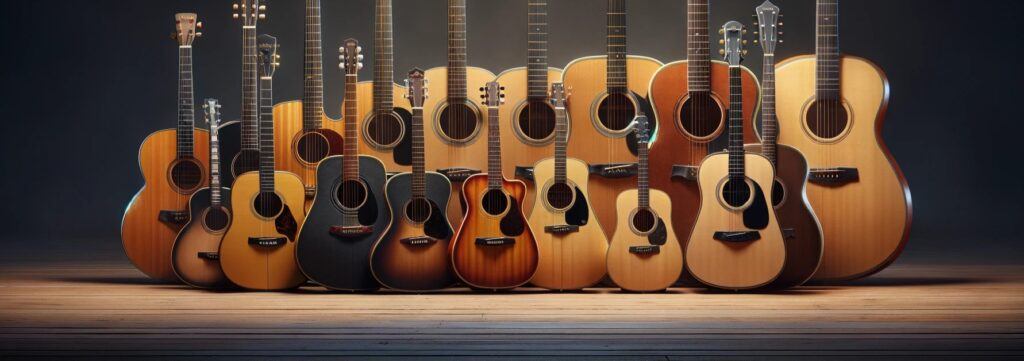
When we step into the diverse world of acoustic guitars, the impact of guitar sizes on playability and sound can’t be overstated. Whether you’re seated by the campfire or standing on a stage, the size of your guitar will shape your musical voice and journey. Let us guide you in finding the perfect acoustic guitar that resonates with your style and ambition.
Finding the Right Guitar Size and Body Shape
It’s crucial to recognize that acoustic guitar sizes influence not only the comfort of your playing position but also the tonal quality of the instrument. A smaller body guitar, for example, offers the clarity and prominence of higher frequencies, making it an excellent choice for finger-picking styles.
On the other hand, larger guitars, like Dreadnoughts or Jumbos, are celebrated for their powerful projection and deep, rich tones that fill any room with a resonant warmth.
Consider your physical comfort, the genre of music you aim to play, and the environments in which you’ll be playing when selecting your guitar’s body shape and size.
Travel Guitars vs. Full-sized Guitars
- Travel Guitars: Compact, portable, and easier to handle for younger players or those with smaller frames.
- Full-sized Guitars: Offer a fully immersive strumming experience with a sound that’s as robust as its build – perfect for a varied musical repertoire.
I understand that choosing between a travel guitar and a full-sized model can be a tug-of-war between convenience and acoustic richness. Let your lifestyle and musical objectives navigate this choice, and you’ll be strumming the perfect chords on an acoustic that feels like an extension of your creative spirit.
Recommended Brands and Models for Beginners

As we explore the journey of choosing the perfect acoustic guitar for beginners, we focus on the recommended brands that consistently deliver quality and playability.
These brands have established themselves as pillars in the music community, offering top models that align perfectly with the needs of first-time guitarists.
Trusted Brands for Beginner Acoustic Guitars
Among the wide spectrum of guitar brands, Fender, Yamaha, and Taylor stand out as some of the most trusted names. These companies have garnered respect for their dedication to producing instruments that cater to the new musician without sacrificing quality.
Their commitment to crafting beginner acoustic guitars has made them favorites in the music industry, trusted by educators and professionals alike.
Top Models for First-Time Guitarists
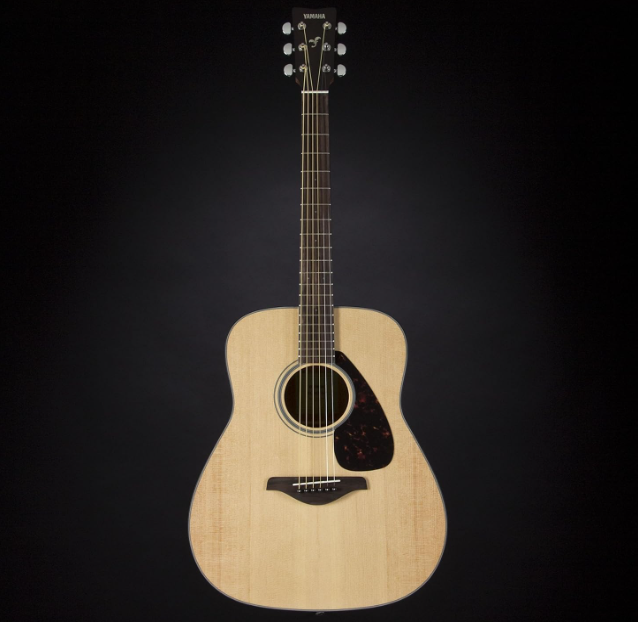
Yamaha FG800
When it comes to choosing the specific models appropriate for beginners, a few rise to the top. The Yamaha FG800 is often celebrated for its clear sound and comfortable playability, coupled with an attractive price point that doesn’t intimidate novices.
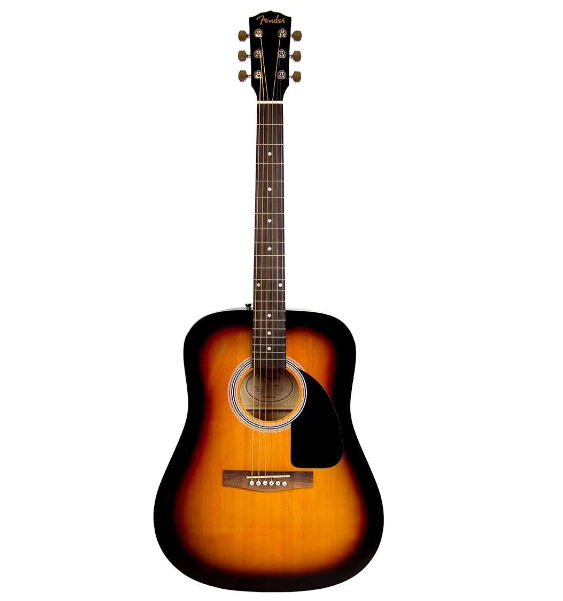
Fender FA-115
The Fender FA-115 follows a similar storyline, known for its durability and rich tonal balance that can suit a variety of playing styles. These models are frequently recommended because they strike a harmonious balance between cost and quality, making them excellent choices for beginner acoustic guitars.

Taylor Academy 10
The Taylor Academy 10 is tailored specifically for learners. Although it may seem highly priced compaired to other makes of beginner guitars, the reason for this is Taylor aim to offer the utmost in playability comfort and quality as you expect from a Taylor made product.
This guitar achieves this by combining a solid Sitka spruce top with layered sapele for the back and sides of the guitar. A standout feature, typically found on high-end models, is the integrated armrest. This innovation rounds off the edge on the lower treble-side bout of the guitar body, significantly improving comfort for the player.

My Starter Guitars Within Your Budget
Understanding what you can afford is the very foundation of finding the best starter guitar. Whether you are looking for budget acoustic guitars or the best value starter guitars, it’s about getting the most bang for your buck without sacrificing quality. Let’s explore the cost-effective choices that can set the stage for your musical aspirations.

Tanglewood Crossroads TWCR-OE
I acquired this guitar last year as part of an upgrade, and it set me back about £120, or roughly $150, as a second-hand purchase.
While it may not be top-of-the-line, it suits my needs perfectly and delivers excellent sound quality. Shelling out more than £300 was beyond my budget at the time, so this fit the bill.
Some may not agree, but Here’s how I see it. Investing a significant amount in a guitar doesn’t make sense to me until you’ve reached a certain skill level. It’s important to allow yourself the time to learn and commit to the instrument before considering a more substantial investment. This approach ensures that when you do decide to spend more, it’s both justified and rewarding.
The main reason for buying this was simple, it was comfortable, very affordable, and sounds great for my level of playing. All of the attributes you would want as a beginner from your guitar.
Defining Your Budget, Price Ranges of Starter Guitars
Price is a defining factor when it comes to choosing a starter guitar. The market offers a wide spectrum, with some models priced under $100 that make for great entry-level instruments, and others inching up to several hundred dollars, equipped with features that can support your growth as a musician for years to come. Having clarity on how much you’re willing to invest will streamline your search significantly.
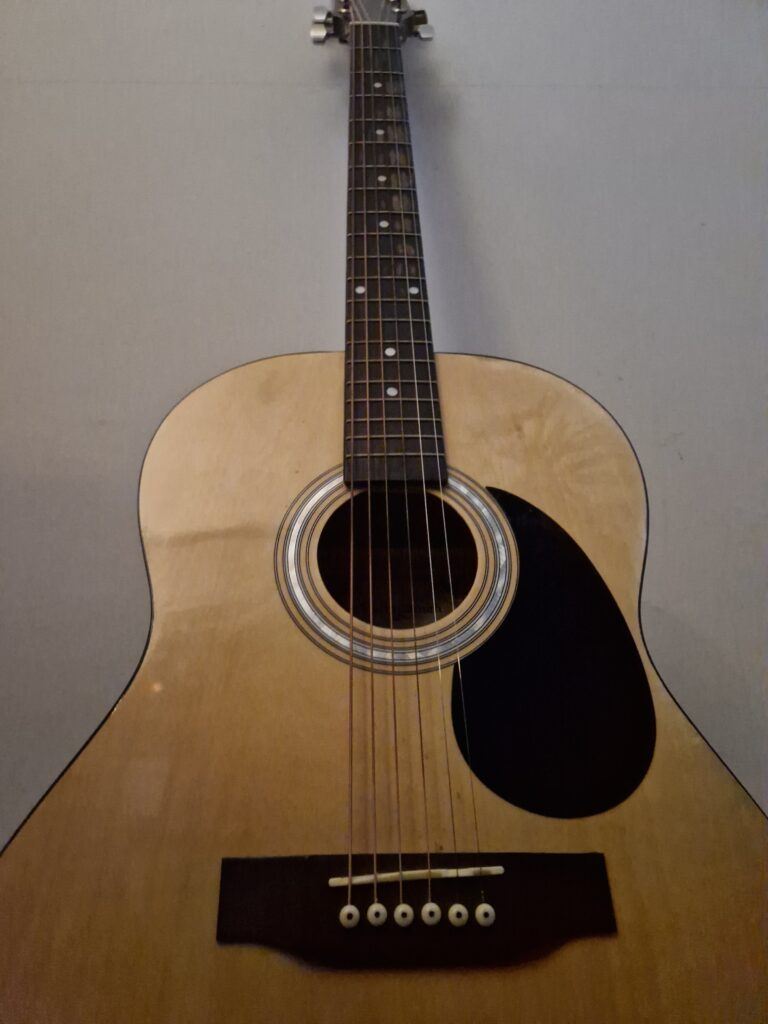
Super low budget Martin Smith
I began my musical journey with a Martin Smith guitar, which cost me about £45 or around $57 and served me well for many years before I felt the need to upgrade. My dedication to mastering the guitar meant that starting with one of the most affordable instruments on the market didn’t bother me at all. Surprisingly, it played smoothly, maintained its tune, and proved to be an excellent guitar in the long run.
This experience underscores an important lesson, possessing a guitar with a solid wood top isn’t the deciding factor in the success of your guitar journey. I’m still practising and playing to this day, regardless.
Tips for Finding Value for Money
It’s also wise to consider expert and customer reviews, which can be invaluable when assessing the real-world performance of the guitars you’re interested in. Whenever possible, I recommend trying out guitars in person to really get a feel for what resonates with you. Here’s a comparison to help guide your decision:

Remember, the right acoustic guitar isn’t always the most expensive one. It’s the instrument that feels good in your hands, sounds good to your ears, and doesn’t strain your wallet.
The models mentioned above come from trusted brands known for their quality and reliability, especially for those just starting on the acoustic guitar. I’ve kept the list short for a reason. While I could dive deep into a wide range of guitars, detailing every specification, the truth is, the most effective way to discover the perfect guitar for you is to step into a music store and test several yourself. This leads us to our next topic.
Buying Your Guitar Online Stores vs Local Music Shops

When it’s time for guitar purchasing, the decision on where to buy your instrument is as vital as the guitar itself. The modern musician has the luxury of choice between convenient online guitar stores and traditional local music shops. Each avenue offers unique advantages that can dramatically influence your buying experience.
The Pros and Cons of Buying Guitars Online
Online stores will provide you with more options, allowing you to explore an extensive inventory that local stores might not match.
They often entice with lower prices due to larger volume sales and fewer overhead costs. However, the primary drawback is the absence of physical interaction.
You can’t feel the guitar’s weight, check its balance, or hear its unique acoustic properties through a screen. Despite detailed product descriptions and customer reviews, you risk an element of surprise upon the guitar’s arrival.
The Benefits of In-Store Purchases
Local music shops shine when it comes to personalized service. They offer the chance to physically inspect and test various guitars.
Store staff often includes experienced musicians who can provide expert advice tailored to your specific needs. Moreover, there’s no waiting for delivery. You can walk out the store with your chosen guitar, ready to play.
The limitation, however, may lie in a potentially higher price and a smaller selection compared to the vast online market.
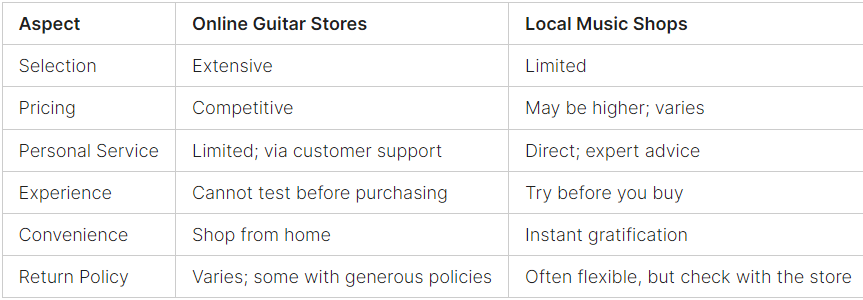
To wrap this section up, both online guitar stores and local music shops have their merits for guitar purchasing. I recommend assessing what factors hold the most weight for you – price, selection, service, or instant access. Above all, purchasing from a reputable seller and understanding the return policy is paramount to ensure a positive guitar-buying experience.
Essential Accessories for Your New Guitar

Having the right guitar accessories can significantly enhance your experience. The number one accessory for me has been the Capo, but below we look at more items that you need to give you that head start.
- Tuner: Ensures your guitar is always ready to play with perfect pitch
- Case/Gig Bag: Protects your guitar during transportation and storage
- Strap: Provides comfort and support while playing, especially when standing
- Picks: These little plectrums allow for a variety of playing styles and dynamics
- Capo: Expands your creativity by enabling faster key changes
- Stand: Keeps your guitar securely upright and within easy reach during breaks
While some may think accessories can be secondary, I believe that having them from day one establishes a sound playing foundation. A wise selection of guitar accessories can prevent common beginner frustrations and contribute to a smoother learning curve.
Remember, every little piece adds up to a comfortable and inspiring practice environment, keeping the focus where it belongs—on the joy of making music.
Daily Guitar Practice Made Easy, Practical Tips For Beginners
Maintaining Your Acoustic Guitar for Longevity
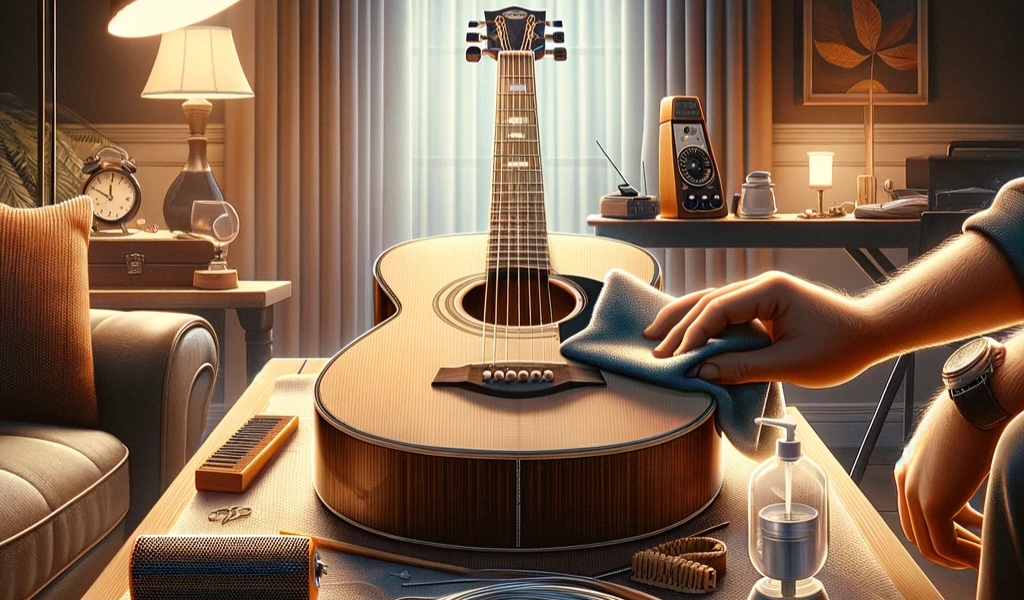
Basics of Guitar Care
Proper guitar care starts with the simplest routine but is often overlooked. Regular cleaning will eliminate Dust, grime, and oils from your fingers that accumulate on the strings and body, affecting the sound and playability.
Keep your guitar in a stable environment, protected from harsh temperatures and humidity, to safeguard the wood from damage. Regularly wiping it down with a soft, dry cloth can significantly preserve its shine and overall well-being.
Furthermore, ensure your guitar is always within reach and ready to play. This accessibility can greatly diminish the temptation to skip practice sessions and help you stay consistent in your musical journey.
Key Maintenance Routines to Follow
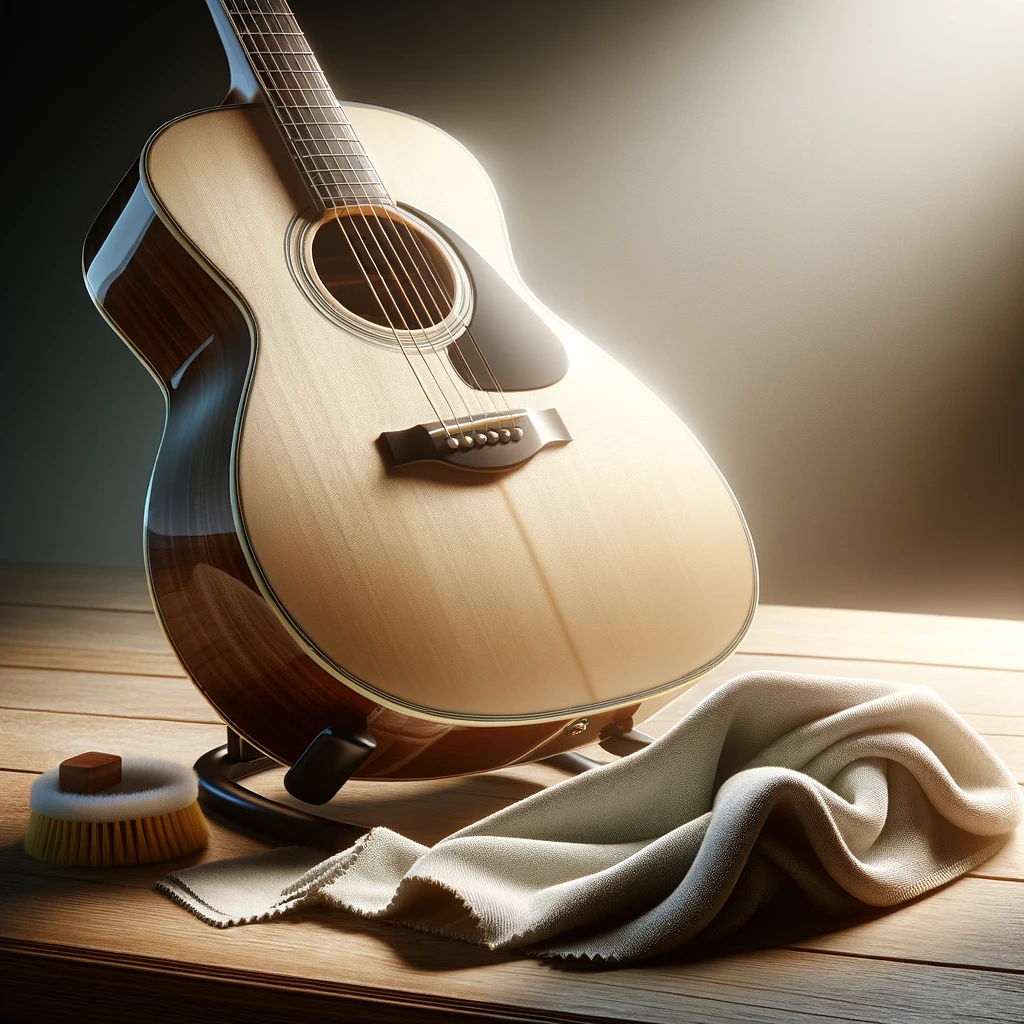
Keeping up with maintenance routines significantly ensures that your acoustic guitar remains a reliable companion on your musical journey. Let’s look at some key routines you should adopt:
- Changing strings regularly to prevent loss of tone and intonation issues.
- Checking and adjusting the truss rod to ensure proper neck alignment.
- Monitoring the guitar’s intonation for consistent pitch across the fretboard.
Following these maintenance steps not only enhances the playability of your guitar but also fortifies its durability. Now, for better clarity, here’s a detailed table highlighting the frequency and importance of these care routines.

By incorporating these tasks into your routine, you ensure that your guitar continues to resonate with the passion and dedication with which you play. Remember, a well-cared-for guitar is a source of pride and joy, capable of providing exquisite music for you and your audience.
Conclusion
I sincerely hope this guide has illuminated the way, as you start the journey of selecting your first acoustic guitar. Remember, the guitar you pick is not just an assembly of wood and strings, it’s the spark that will ignite your growing love for music.
Here’s to the joy and experiences the acoustic guitar will bring into your life, accompanied by the melodies you’ll create.
martin@chordexplorer.com




